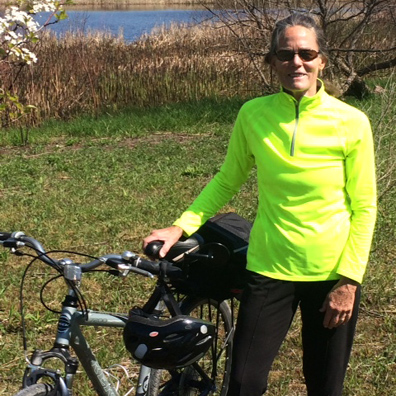
Imagine slamming into a tree going more than 20 miles per hour with only the protection of a helmet. Imagine that same scenario, but as a petite downhill skier getting hit so hard by a snowboarder that you are lifted off the snow and thrust into a pine tree becoming a human airbag. According to avid downhill skier Mary Falck, that happened to her while vacationing in Colorado. Understandably, Falck does not remember much about the accident, but the severe injuries that resulted—a fractured pelvis, femur, wrist and ankle, as well as multiple torn knee ligaments—would become her biggest challenge. “I just completed a more rigorous ski run where I achieved the million vertical feet mark for the year,” Falck explained. “To celebrate and unwind, my husband and I decided to take another run, but on a less difficult slope. That decision changed the next two years of my life and potentially the rest of my life,” she said.
After the Ski Patrol stabilized Falck, they helicoptered her to Denver where she underwent emergency surgery. “I was in intensive care for several days before moving to in-patient rehabilitation where I stayed for three weeks until I was able to travel,” she lamented.
Falck explained her recovery process was incredibly difficult and long. The fractures on the right side of her body healed slowly with her ankle taking the longest. However, her unrepaired left knee made her unstable and physical therapy nearly impossible. “I was so frustrated by that point my husband contacted the orthopaedic surgeon he’d seen at Hinsdale Orthopaedics,” she said. “He referred her to his partner, Dr. Steven Chudik.” Previous doctors Falck saw told her a total knee replacement was her only option because her knee was in such bad condition. She was hopeful Dr. Chudik would tell her something different.
According to Dr. Chudik, a board certified and fellowship trained orthopaedic surgeon and sports medicine physician, Falck’s injuries were so severe he could not put her through knee surgery and more rehabilitation until she was healed and able to walk. “Quite honestly, I didn’t think she would be able to have a successful outcome until her injuries healed,” he explained. “So despite her strong objections and repeated protests, I told her I would not operate until she was in a better overall functional condition. It is important to me to treat each patient individually and not necessarily ‘by the book’ because everyone has different functional and lifestyle goals,” Dr. Chudik added.
For the next six months, Falck never missed a physical therapy session determined to get her right side fully rehabilitated. However, her injured left knee hindered her in therapy and caused her extreme frustration. “My knee buckled during a therapy session and by then I’d had enough,” she said. “I made another appointment to see Dr. Chudik. We discussed my options and injuries—torn ACL, PCL, and PLC (anterior and posterior cruciate ligaments, and posterior lateral corner ligaments), severe cartilage damage and arthritis of the knee. “Despite the extent of the damage, I refused to accept that I could not regain my previous life style,” she explained.
“Given the severity of her injuries, a total knee replacement was the only reliable option. But, that wouldn’t guarantee she’d be able to return to her previous level of skiing,” Dr. Chudik said. “Conversely, ligament reconstruction with her severe cartilage damage and arthritis would likely produce permanent loss of motion, weakness and inability to ski,” he explained.
Determined to ski, Falck elected to proceed with surgery. Dr. Chudik performed
an anatomic, multiple knee ligament reconstruction and coached her through the difficult rehabilitation. “Dr. Chudik warned me it would be a long recovery,” Falck said. “But I did it!
Two years after her accident, Falck resumed the active life she loves–even skiing.